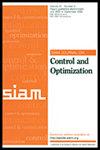带吸收的奇异控制中的最大化原理及其在红利问题中的应用
IF 2.4
2区 数学
Q2 AUTOMATION & CONTROL SYSTEMS
引用次数: 0
摘要
SIAM 控制与优化期刊》第 62 卷第 1 期第 91-117 页,2024 年 2 月。 摘要。受经典红利问题新表述的启发,我们证明了 Peskir 最大化原理可以转移到具有二维退化动力学和沿状态空间对角线吸收的奇异随机控制问题上。我们将最优控制构造为沿移动障碍的 Skorokhod 反射,其中障碍可作为特定非线性 ODE 的最小解进行分析计算。与股息问题的经典一维表述不同,当公司的(股息前)股权资本以几何布朗运动的形式演变时,我们的框架会产生一个非难解。这种解与传统的算术布朗运动解也有本质区别。本文章由计算机程序翻译,如有差异,请以英文原文为准。
The Maximality Principle in Singular Control with Absorption and Its Applications to the Dividend Problem
SIAM Journal on Control and Optimization, Volume 62, Issue 1, Page 91-117, February 2024.
Abstract. Motivated by a new formulation of the classical dividend problem, we show that Peskir’s maximality principle can be transferred to singular stochastic control problems with two-dimensional degenerate dynamics and absorption along the diagonal of the state space. We construct an optimal control as a Skorokhod reflection along a moving barrier, where the barrier can be computed analytically as the smallest solution to a certain nonlinear ODE. Contrarily to the classical one-dimensional formulation of the dividend problem, our framework produces a nontrivial solution when the firm’s (predividend) equity capital evolves as a geometric Brownian motion. Such a solution is also qualitatively different from the one traditionally obtained for the arithmetic Brownian motion.
Abstract. Motivated by a new formulation of the classical dividend problem, we show that Peskir’s maximality principle can be transferred to singular stochastic control problems with two-dimensional degenerate dynamics and absorption along the diagonal of the state space. We construct an optimal control as a Skorokhod reflection along a moving barrier, where the barrier can be computed analytically as the smallest solution to a certain nonlinear ODE. Contrarily to the classical one-dimensional formulation of the dividend problem, our framework produces a nontrivial solution when the firm’s (predividend) equity capital evolves as a geometric Brownian motion. Such a solution is also qualitatively different from the one traditionally obtained for the arithmetic Brownian motion.
求助全文
通过发布文献求助,成功后即可免费获取论文全文。
去求助
来源期刊
CiteScore
4.00
自引率
4.50%
发文量
143
审稿时长
12 months
期刊介绍:
SIAM Journal on Control and Optimization (SICON) publishes original research articles on the mathematics and applications of control theory and certain parts of optimization theory. Papers considered for publication must be significant at both the mathematical level and the level of applications or potential applications. Papers containing mostly routine mathematics or those with no discernible connection to control and systems theory or optimization will not be considered for publication. From time to time, the journal will also publish authoritative surveys of important subject areas in control theory and optimization whose level of maturity permits a clear and unified exposition.
The broad areas mentioned above are intended to encompass a wide range of mathematical techniques and scientific, engineering, economic, and industrial applications. These include stochastic and deterministic methods in control, estimation, and identification of systems; modeling and realization of complex control systems; the numerical analysis and related computational methodology of control processes and allied issues; and the development of mathematical theories and techniques that give new insights into old problems or provide the basis for further progress in control theory and optimization. Within the field of optimization, the journal focuses on the parts that are relevant to dynamic and control systems. Contributions to numerical methodology are also welcome in accordance with these aims, especially as related to large-scale problems and decomposition as well as to fundamental questions of convergence and approximation.

 求助内容:
求助内容: 应助结果提醒方式:
应助结果提醒方式:


